#lgmd
Explore tagged Tumblr posts
Text
Disability, Cures, and the Complex Relationship Between Them
So, I've been thinking a lot lately about cures, just in general, as a concept. I've been watching the excellent videos of John Graybill II on Youtube, where he demonstrates his day-to-day movements as someone with Limb Girdle Muscular Dystrophy 2a, and updates every year to show how it progresses. I'm currently writing a character with LGMD and wanted to be sure I understand exactly how it impacts his daily life and movement limitations, so this has been extremely helpful, because there's only so much you can glean from a list of symptoms.
Quick Background on John Graybill II
John started this series in 2007/8, back when he was about 30 years old. He was diagnosed when he was 17, back in '95, and, when he started this series, he was very much fighting his LGMD, in a constant struggle, and angry with himself and the condition. In this, he directed a lot of toxic positivity at himself and became convinced he could defeat LGMD with positive thinking, healthy diet, etc.
Now, while I respect that there are positives to this (exercise and eating well is rarely a bad thing, and the stretches he does almost certainly have helped him to lengthen his time with mobility), there is also something to be said for accepting a physical disability for what it is. In later videos, he clearly had shifted that mindset toward something a bit more realistic. Where, in the beginning, he had been certain that he would somehow heal himself through positivity and such, he later says that may never happen, and he wants to enjoy doing what he can, while he can, instead of being in a constant battle with himself.
That being said, he does run an organization (I believe he runs it?) that seeks to fund research and find a cure for muscular dystrophy of this particular variety. And, while watching his videos from oldest to newest, I've been grappling with my complicated feelings regarding cures.
Why Are Cures a Complicated Topic?
The reason cures are a complicated topic is because, for a lot of us, cures are unlikely to ever be developed - at least not within our lifetimes and probably not within our children's lifetimes. Many physical disabilities and disorders are just too rare, too unknown, the cause unclear. For us, we have to just accept that this is something we have to live with, for better or for worse.
The other reason is that people are often proponents of seeking cures for things that don't need curing, such as autism. Obviously I haven't polled every autistic person alive, but I have known and read content from countless autistic people. I don't think I've ever found a single autistic person who wanted to be cured of autism. In fact, I would say most of them were pretty vocally oppositional toward the idea, for good reason. 90% of the difficulty that comes with being autistic comes from societal ableism and accessibility issues on a systemic level.
My Thoughts on Cures
I can't speak for everyone with incurable physical disabilities that are unlikely to have a cure developed, nor can I speak for everyone who's autistic, but, speaking for myself, talk of cures can be extremely uncomfortable to me.
I asked myself why. Because, in reality, there shouldn't be anything wrong with researching a cure for something like LGMD. It causes people great difficulty and often great pain. For certain variants, it causes early death.
And, after reflecting on my feelings for a long while, I think I've figured out why the word and the concept bothers me so much.
Cures Are Often Used as a Crutch for Ableism
There are, broadly speaking, two camps of people who want cures:
People who want to improve their quality of life, the quality of life of someone they love, or who want to prevent future generations from the difficulty they or a loved one have been dealt
People who are uncomfortable with disability and want it to go away
This is a venn diagram with a large overlap. The number of people who are purely in camp 1 is much smaller than you might hope.
Why Is Wanting to Get Rid of Disability a Problem?
Okay so here's why camp 2 is a problem. Let's say, for the sake of the argument, that every disability has a possible cure that just has to be found. Why is that a problem? Disability is bad, right?
Wrong! Disability is completely amoral - it has no goodness or badness. It just is. Ideally, some of the more painful disabilities could be cured to prevent pain and early death. However, the problem with viewing disability, in a vacuum, as bad, is that your opinion of the disability will inevitably rub off on the people with the disability.
When you view disability as an adversary, you view disabled people as a problem to solve.
Just as John Graybill II explains in one of his stair-climbing videos a few years into the series, he had spent so long trying to fight the progression of the illness, that he had spent every day in passive anger and frustration. He had forgotten to just enjoy his ability to climb stairs. And he said that he wished he could go back and just enjoy it - stop timing himself on his stopwatch and trying to beat his times. Basically, even as a disabled man himself, he had spent so long looking at his disability as a problem to fix, he hadn't been properly enjoying being a person and just living his life.
When you apply the same fix-it approach to someone who doesn't have a disability, it's equally easy for them to forget the personhood of the people with disabilities. Only, instead of it being directed at themselves, it is directed at others. They push their disabled loved ones to just try harder, just push harder and for longer, eat right, try this, do that, think right, take vitamins - if you just try hard enough, you can beat this!
Except... most of the time, you can't.
The idea that doing everything right will allow you to beat a chronic illness is just ableism in a scientific hat. You're afraid - of being disabled, of the consequences of disability, of someone you love being different, of them looking weird, becoming weird, being seen in public yourself or with someone disabled, of being uncomfortable, of having to put in more energy and effort into helping someone with special needs.
The list of things people are afraid of is endless, and the positive spin on that ableism is simply fighting to fix it.
Make it go away so that you don't have to deal with it anymore.
And then, when you take that approach and apply it to the countless disabilities that don't have cures and may never have cures, you end up with boatloads of people who are seen as problems to solve. They feel like a burden to their family and friends. They're pushed to do what hurts and will actually cause more long-term problems for them by forcing themselves to do things they shouldn't be doing - things that damage their bodies, which aren't meant to do those things anymore.
The Long-Term Consequences of Ableist Pushes for Cures
So back to that argument about all disabilities being curable with time: what's the problem with making some disabled people uncomfortable if, one day, all disability is cured and there are no more disabled people?
Well, the simple answer is this: that's never going to happen, and if you think that way, you're a eugenicist.
Even if every disability is curable with time, the ends do not justify the means - the means being to humiliate and degrade disabled people by treating them like problems.
And it would take decades, maybe even centuries, of those means to even reach the ends. But we'll stop that argument there, because there will never be an end to disability.
Why There Is No End to Disability
So, the thing about disability, is it will never cease to exist. Even if it was a good goal to have, which it isn't, it's never going to happen.
Disability is often caused by gene mutation. At one point, none of the gene mutations for our current physical disabilities existed. They developed. And, just as the current disabilities developed over time and with gene mutations, so will new and different ones. Even if we cured all of the current disabilities, there would always be new ones, likely developing as fast as we can cure the existing ones.
Additionally, a lot of disability is not congenital. People who are in accidents and lose legs will never be able to regrow those legs. Even if eugenicists managed to prevent any "deformed" babies from being born without limbs, people would lose them from accidents and infection, and all kinds of things.
In a world where all congenital disabilities were cured, what quality of life do you expect people in wheelchairs to have?
Because I think I can confidently say that, if everything congenital were cured, a day wouldn't pass before accessibility laws were thrown out the window. We would be returned to the days where disabled people are hidden away and can't leave the house - kept as shameful secrets by families who resent them, or shown off as paragons of strength and virtue when/if they're able to be fitted with a working prosthetic.
Neither of these outcomes is positive.
The Slippery Slope of Cure Ideology
So, on to another argument: there is a lot of danger in letting cure ideology go unchallenged.
I want to clarify again, that I don't think we should never research cures. I'm challenging, specifically, the social movement behind cures that is often driven by eugenicism and ableism.
So, why is it dangerous to let that exist? Well, let's look back at the reason I mentioned that people are in camp 2: they are afraid of being uncomfortable. They are afraid of what's different from them. They view difference as a problem to be solved - a disease or a disorder.
You can see this exact principle in action when people fight for a cure for autism. It's being fought for by the allistics who know people with autism, not usually the autistics themselves. It's being fought for by parents who are angry that their child is different or won't look them in the eyes. They see them as an obstacle to overcome, not as a person who has a different way of socializing. Even in the best case, where they see them as a person more than a problem, they are seen as a person with a wrong and disordered way of socializing.
Imagine, for a moment, that there was an allistic trait that people treated as disordered or wrong the way an ableist might treat hand-flapping or lining up toys. Let's take a direct comparison - something one does when they're happy - like laughing. Imagine, for a moment, that something you do when you're joyful, is treated like a maladaption. Perhaps, in this alternate universe, smiling is normal, but laughing is disturbing to people. You spend your life desperately trying to repress your laughter, hiding your joy, even though it's the most natural thing in the world to you. How would you feel hearing people chanting positively, with smiles, taking donations, running marathons and dancing, all for a cure for laughter?
Really, really, genuinely think about it.
Imagine living your entire life like that.
This doesn't just relate to autism.
The reason this ideology has to be challenged is not just by the concrete example of people trying to cure autism, it's the root of the ideology, that different is bad. That the majority being uncomfortable means the minority is wrong and needs to be fixed.
Is this ringing any other bells for you? Because autism isn't the only thing I desperately hope they don't find a genetic link for.
If fighting for a cure for anything people deem different and weird enough goes unchallenged, people will attempt to cure anything they don't like. Like being gay. Or being trans.
And I'm not talking about conversion camps that try to brainwash you into thinking you're not gay. I'm not talking about the abusive Christian approach, I'm talking about the eugenicist scientist approach.
If a genetic link were found or if there was some kind of actual biological difference, that could mean people trying to test fetuses for the "homosexuality gene" or whatever. It would give a concrete path for eugenicists to try preventing gay and trans people from ever even being born.
And, if that biological connection is found, how long do you think it would take for people to start excitedly pushing for a cure to "homosexuality" or "transgenderism"?
What is the point of this post?
It's food for thought.
I want, not only my abled followers, but my disabled ones as well, to reflect on how they feel about cures - about being cured or about curing others.
I want you all to ask yourself, am I in camp 1 or camp 2?
Your goal in supporting a cure should be to prevent death, to prevent pain that cannot be overcome through systemic support and accessibility, to help people live lives with quality.
Your goal in supporting a cure should never be to remove something that makes you uncomfortable. If you're abled, it should never be to make your life easier or alleviate your feelings of guilt, resentment, or stress. It should never be to make people normal, especially not people you care about.
And, on a final note, remember that the things you see in a disability you know nothing about may not have anything to do with reality. If you see a disability for the first time and you immediately wish for a cure for it, simply because it looks painful, maybe find out if it actually is first. Sometimes we attribute pain and misery to things that are no big deal to the people dealing with them. And, in doing so, we also attribute heroicism and virtue to the people dealing with them - which they did not ask for.
Don't make disabled people into a project. Don't use them as inspiration porn - putting them on a pedestal and using them as proof that "anything is possible."
Treat disabled people with dignity and respect.
Treat disabled people as people, with or without them jumping through every hoop you think will make them better.
Think about how fucking annoying it would be if, every time you got up from a chair in public, everyone stared at you, or even praised you for it. How uncomfortable would you be if no one ever saw you as yourself but as some kind of ambassador for strong, amazing people who are so so so cool because they can tie their shoelaces.
Think about how fucking infuriating it would be if every tenth person you walked past turned to you, looking sad, and said "god bless you."
Think about how old that would get, and how fast.
That's all. Just think about it.
#there are like 6 different points in this post fighting for dominance#i hope you walk away with all 6#disability#ableism#ableism mention#chronic illness#actually disabled#disabled#lgmd#muscular dystrophy#autism#asd#autistic ableism#adriandontlook#queer#lgbt#long#long post#longpost#pots#eds#fibro#fibromyalgia#postural orthostatic tachycardia syndrome#ehlers danlos syndrome
7 notes
·
View notes
Text

30 September is LGMD Awareness Day!
Downloadlink below
To get you ready for this day, you can download my free attention shirts for Sims men on The Sims Resource today! 🎉👕
With this little set, consisting of three different shirts I would like to raise awareness for limb-girdle muscular dystrophy (LGMD).
Limb-girdle muscular dystrophy is characterised by the progressive wasting and weakening of skeletal muscles, particularly in the shoulder and hip areas. It is classified into different forms depending on the severity and age of onset.
Let's make a difference together! 💚
de:
𝔾𝕝𝕚𝕖𝕕𝕖𝕣𝕘ü𝕣𝕥𝕖𝕝-𝕄𝕦𝕤𝕜𝕖𝕝𝕕𝕪𝕤𝕥𝕣𝕠𝕡𝕙𝕚𝕖 𝕊𝕙𝕚𝕣𝕥𝕤 für deine Sims
30. September ist LGMD Aufmerksamkeitstag.
Um euch auf diesen Tag vorzubereiten, könnt ihr euch schon heute meine kostenlosen Aufmerksamkeitsshirts auf The Sims Resource herunterladen! 🎉👕
Mit diesem kleinen Set, bestehend aus 3 Shirts möchte ich auf die Gliedergürtel-Muskeldystrophie (LGMD) aufmerksam machen.
Bei der Gliedergürtel-Muskeldystrophie kommt es zu einem fortschreitenden Abbau und Schwäche der Skelettmuskulatur, vor allem im Schulter- und Hüftbereich. Abhängig von der Schwere der Erkrankung und dem Alter bei Beginn der Erkrankung wird sie in verschiedene Formen unterteilt. LGMD steht für die englische Bezeichnung Limb Griddle Muscular Dystrophy.
Ich lade euch ein, euren Sims diese bedeutsamen T-Shirts zu schenken und mit mir und meinen Sims am 30. September auf die Krankheit aufmerksam zu machen.
Lasst uns gemeinsam ein Zeichen setzen! 💚
📁𝔻𝕠𝕨𝕟𝕝𝕠𝕒𝕕 𝕊��𝕥 𝕗𝕠𝕣 𝔽𝕣𝕖𝕖 on TSR
Terms Of Use:
link back to original post if you recolor/convert
do not put my content behind Patreon or adfly
Credits:
💚 Many thanks to all CC and pose creators.
💚 Herzlichen Dank an alle CC und Posen Ersteller.
#sims with disabilities#sims 4 cc#sims4awareness#the sims resource#sims 4#sims clothes#tsr#sims 4 awareness#LGMD#sims story#simblr#ts4 simblr#disabled sims#muscular dystrophy#muscular
2 notes
·
View notes
Text





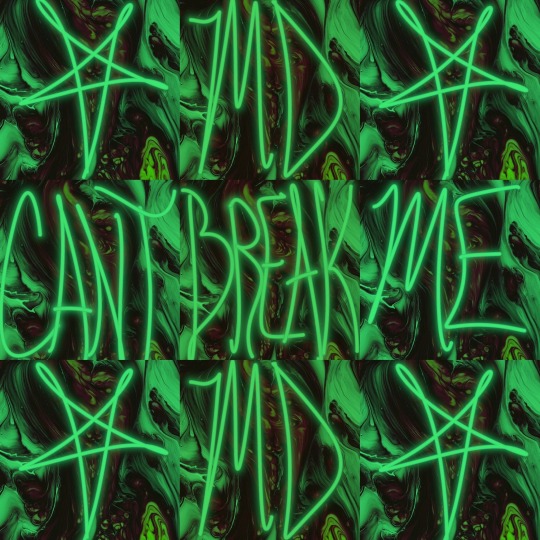
#mdcantbreakme #md #lgmd #art #green #musculardystrophy
0 notes
Text
Marcus Playlists PT.1
This playlist isn’t purely about Marcus, it’s actually about his and my version of Johnny’s mum’s relationship. So warning, there is a mix between happy love songs and pretty sad ones.
Link: https://open.spotify.com/playlist/0puK1brZRLnSkm01vul6Cl?si=ce5e8d53a0e64b43
The Songs I Most Closely Associate With These Two Are:
Gone, Gone, Gone by Phillip Phillips
Before You Go by Lewis Capaldi
Kids Again by Artist vs. Poet
Hold Me While You Wait by Lewis Capaldi
Slight Relationship Explanation For Those Confused:
Jia and Marcus met when he was 23 and she was 21 and started dating soon afterwards. Marcus was permanently disowned from his family and moved in with Jia (who had recently lost her only living relative and was now living alone) within a year as he had nowhere else to go. They were pretty happy together despite everything and got married a few years later.
However, Jia’s LGMD (limb-girdle muscular dystrophy) kept getting worse, eventually leading to her death when Johnny was just 6 years old and Jia herself was 34. Marcus never fully recovered emotionally or mentally from her death and it worsened his abandonment issues (which went on to cause issues with him and his son down the line).
Basically, they were both there for each other during really rough times in their lives and helped the other person grow stronger. They had a loving relationship that was cut off far too early with Jia’s untimely death.
Song List:
Gone, Gone, Gone by Phillip Phillips
Home by Phillip Phillips
Raging Fire by Phillip Phillips
Kaleidoscope by A Great Big World
Don’t Give Up On Me by Andy Grammer
Pompeii by Bastille
Out of My League by Fitz and The Tantrums
Two Birds by Regina Spektor
See You Later (Ten Years) by Jenna Raine
1990something by Sub-Radio
Brave by Sara Bareilles
Line Without A Hook by Ricky Montgomery
Mr Loverman by Ricky Montgomery
Kids Again by Artist vs. Poet
Before You Go by Lewis Capaldi
Hold Me While You Wait by Lewis Capaldi
Like Real People Do by Hoizer
It’s Alright by Mother Mother
Bleeding Out by Imagine Dragons
The Archer by Taylor Swift
Part of Me by Cian Ducrot
#sing#sing 2 (?)#idk he was in both#sing marcus#sing big daddy#sing oc#sing jia (oc)#jia is my version of johnny's mum and I love her so much#jia was a pianist and a primary school music teacher#johnny looks just like her#*quietly gives character a tragic backstory and runs away*#marcus was happy...once#i swear he's happy now too tho#just still misses jia and worries about johnny#but he's ok!! ...kinda#he did lose the love of his life and first person to ever see him for who he truely is but at least he's in therapy now!#sing playlists (kinda)
10 notes
·
View notes
Text
Lgmd Kas Hastaları Türkiye'de İlaç Taleplerini Yeniden Gündeme Getirdi
LGMD Kas Hastalıkları: Nadir Hastalıkların Mücadelesi LGMD (Limber Girdle Muscular Dystrophy) kas hastalıkları, günümüzde birçok bireyi etkileyen nadir hastalıklar arasında yer almaktadır. Bu hastalık, kasların zayıflamasına ve zamanla kaybına neden olan genetik bir bozukluktur. Türkiye’de de bu hastalığa sahip pek çok hasta bulunmaktadır ve bu hastaların talepleri, sağlık sisteminin dikkatini…
0 notes
Text
“Limb-Girdle Muscular Dystrophy”, Victor McKusick, Mendelian Inheritance in Man, 1966.
Here I present: “Limb-Girdle Muscular Dystrophy”, Victor McKusick, Mendelian Inheritance in Man’, 1966. INTRODUCTION. Limb–girdle muscular dystrophy (LGMD) is a genetically heterogeneous group of muscular dystrophies that share a set of clinical characteristics. It is characterized by progressive muscle wasting which affects predominantly hip and shoulder muscles. LGMD usually has…

View On WordPress
0 notes
Text
Muscular Dystrophy Treatment: An Overview of Current and Emerging Therapies
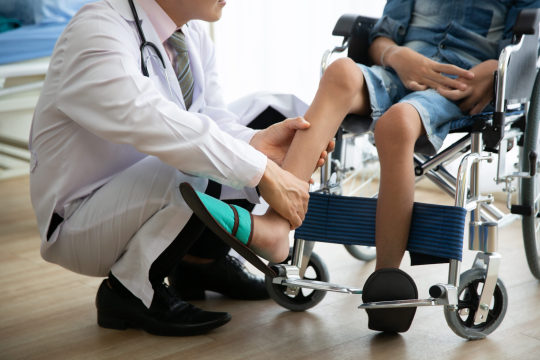
Muscular dystrophies are a group of genetic diseases that weaken the muscles over time. While there is no cure, ongoing research looks to improve treatments and quality of life for patients. Types of Muscular Dystrophy There are several different types of muscular dystrophy. The most common are: - Duchenne muscular dystrophy (DMD): A severe form that affects boys typically beginning between ages 3-5. Over time, it causes progressive muscle degeneration and loss of ambulation. Gene therapy and exon skipping hold promise to treat the underlying cause. - Becker muscular dystrophy (BMD): A milder variation of DMD that progresses more slowly over time. Treatments focus on managing symptoms and delaying functional decline. - Limb-girdle muscular dystrophy (LGMD): A group of conditions characterized by gradual weakening of the shoulder, pelvic, and other proximal muscles. Over 30 subtypes are known with varying causes and symptoms. - Facioscapulohumeral muscular dystrophy (FSHD): Causes weakness in the face, shoulder blades, and upper arms. Physical and occupational therapy help maximize function. - Myotonic dystrophy (DM): The most common adult form, it causes myotonia (delayed muscle relaxation) and other multi-system symptoms. Management focuses on complications. Current Muscular Dystrophy Treatment Approaches While there is no cure for muscular dystrophy, current treatment strategies aim to improve quality of life by managing symptoms, preserving function, and delaying disease progression. Physiotherapy/Occupational Therapy: Early intervention with exercises tailored to the individual can improve mobility, muscle strength, flexibility, and delay loss of function. Heat/cold therapies, bracing, and adaptive equipment also help. Corticosteroids: For DMD patients, daily corticosteroids like deflazacort or prednisone can modestly prolong ambulation by reducing inflammation and strengthening muscle fibers. However, long-term use risks side effects. Assistive Devices: Wheelchairs, braces, walkers, and lifts help patients carry out daily living activities as their condition advances. Proper fitting is important to avoid injury. Orthopedic Surgeries: Scoliosis correction, tendon lengthening, and joint replacement surgeries address specific muscular dystrophy complications and functional limitations. Nutritional Supplements: Creatine monohydrate supplements may provide small benefits for some patients by increasing phosphocreatine stores in muscles. A balanced, calorie-appropriate diet supplies needed nutrients. Emerging Muscular Dystrophy Treatments for Genetic Causes In the last decade, significant progress has been made in the development of therapies targeting the genetic roots of muscular dystrophies. These include: Gene Therapy: For DMD, gene therapy aims to restore dystrophin production through direct delivery of new genes or editing of existing genes. Several clinical trials show promise of improved motor function. Exon Skipping: Certain antisense oligonucleotides are being developed to "skip over" specific exons in the dystrophin gene, allowing for an altered but still functional protein to be produced. Exondys 51 is FDA-approved for DMD. Read-Through Drugs: Compounds like ataluren aim to induce "read-through" of premature stop codons in dystrophin gene transcripts, allowing for full-length protein formation. Studies are ongoing. Anti-Inflammatory Drugs: Mitigating inflammation in muscle tissues may help slow disease progression. drugs like eteplirsen for DMD are under investigation. Stem Cell Therapy: Some sources hope stem cells may one day directly replace or regenerate damaged muscle fibers, but this approach remains experimental.
#Muscular Dystrophy Treatment Analysis#Muscular Dystrophy Treatment Growth#Muscular Dystrophy Treatment Share.
0 notes
Text
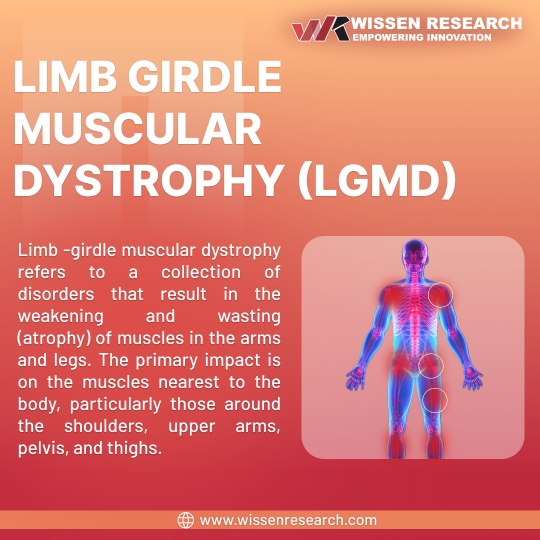
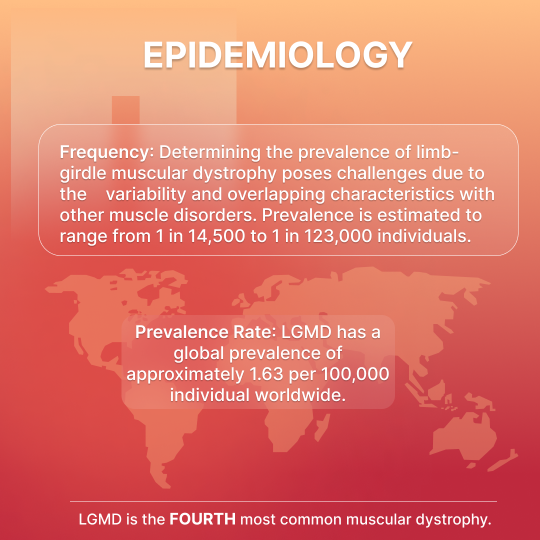
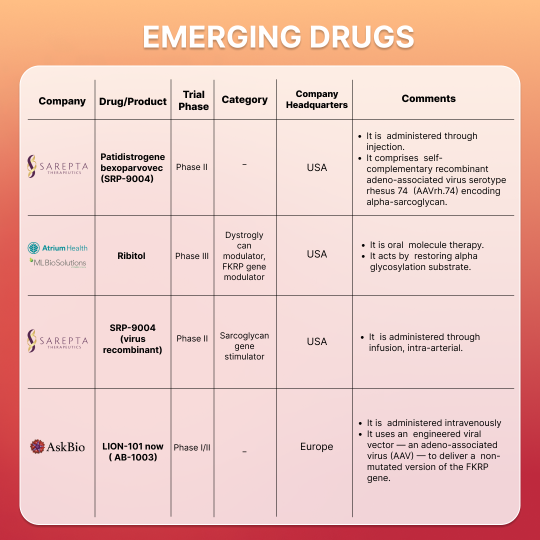
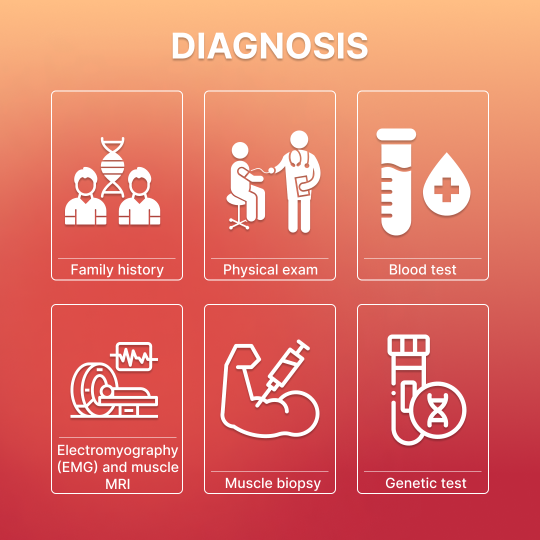
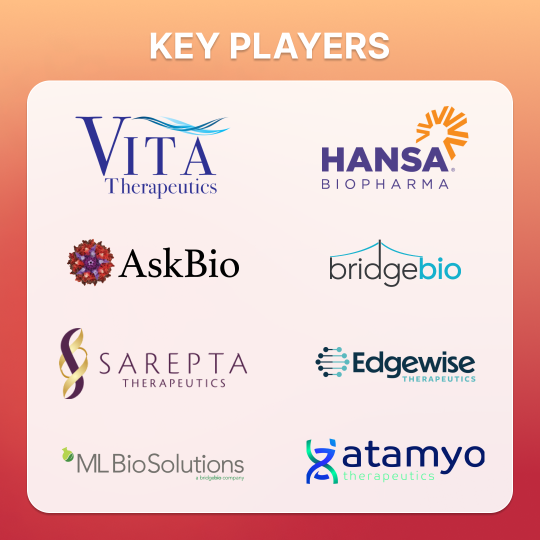
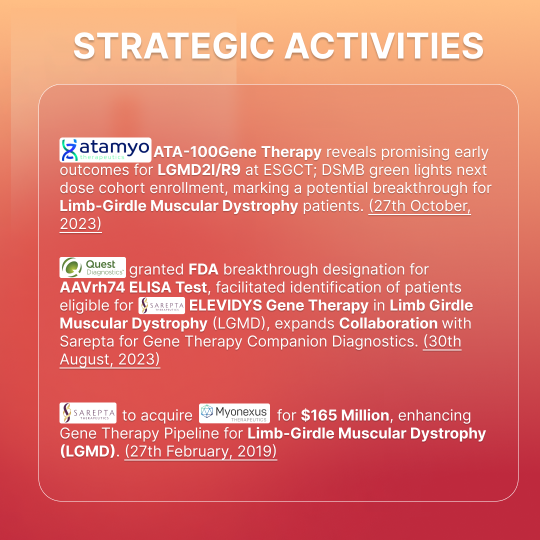

𝗘𝘅𝗽𝗹𝗼𝗿𝗶𝗻𝗴 𝗠𝗮𝗿𝗸𝗲𝘁 𝗜𝗻𝘀𝗶𝗴𝗵𝘁𝘀: Limb Girdle Muscular Dystrophy (LGMD)
Curious about the latest advancements in the field of Limb Girdle Muscular Dystrophy (LGMD)?
Look no further! Wissen Research brings you an in-depth report that sheds light on every aspect of this disease, highlighting: #MarketInsights #ProductAnalysis #CompetitiveAnalysis #PatentAnalysis #ClinicalTrials #Treatment #OpportunityAnalysis #marketforecast #marketresearch #marketreport #marketforecast #askforcustomization #wissenresearch #marketinsights #LimbGirdleMuscularDystrophy #LGMD
0 notes
Text
Limb Girdle Muscular Dystrophy (LGMD) Market Anticipating Remarkable Growth by 2032, Asserts DelveInsight | ML Bio Solutions, Asklepios, Sarepta, Atamyo, Edgewise, Vita Therapeutics, BridgeBio
http://dlvr.it/SxGyyF
0 notes
Text
Limb Girdle Muscular Dystrophy (LGMD) Market Anticipating Remarkable Growth by 2032, Asserts DelveInsight | ML Bio Solutions, Asklepios, Sarepta, Atamyo, Edgewise, Vita Therapeutics, BridgeBio
http://dlvr.it/SxGvhC
0 notes
Text
Limb Girdle Muscular Dystrophy (LGMD) Market Anticipating Remarkable Growth by 2032, Asserts DelveInsight | ML Bio Solutions, Asklepios, Sarepta, Atamyo, Edgewise, Vita Therapeutics, BridgeBio
http://dlvr.it/SxGvbB
0 notes
Text
Limb Girdle Muscular Dystrophy (LGMD) Market Anticipating Remarkable Growth by 2032, Asserts DelveInsight | ML Bio Solutions, Asklepios, Sarepta, Atamyo, Edgewise, Vita Therapeutics, BridgeBio
http://dlvr.it/SxGvb0
0 notes
Text
Limb Girdle Muscular Dystrophy (LGMD) Market Anticipating Remarkable Growth by 2032, Asserts DelveInsight | ML Bio Solutions, Asklepios, Sarepta, Atamyo, Edgewise, Vita Therapeutics, BridgeBio
http://dlvr.it/SxGk5h
0 notes
Text
It’s disability pride month and I’d just like to give a shout-out to everyone with a degenerative or progressive disability.
To everyone with amyotrophic lateral sclerosis, syringomyelia, dementia, muscular dystrophy, cystic fibrosis, charcot-marie tooth, Huntington’s, osteoarthritis, and others.
To all the young people who aren’t sure how far their disability will progress.
To everyone who’s scared they eventually won’t be able to do something they love doing because of their disability.
To everyone who wants to be proud of their condition but is also scared of it.
I see you. Your life has worth and value. Don’t give up.
#this post is partially for me bc my dystrophy is progressing recently#but mostly for my metaphorical siblings with degenerative disease#who even in the disability community are shunned#ik its a little cheesy and yes this is tumblr but HAVING A DEGENERATIVE DISEASE IS HARD AS FUCK#and nobody wants to talk about it ever bc its really sad#lots of the things i love doing are physical like sewing#and ik that one day i wont be able to do those anymore because my arms will be too weak to hold anything#muscular dystrophy#fsh muscular dystrophy#limb girdle muscular dystrophy#lgmd#fshmd#fshd#duchenne#duchennes#duchenne muscular dystrophy#syringomyelia#als#amyotrophic lateral sclerosis#lou gehrigs disease#cystic fibrosis#terminal illness#degenerative disease#degenerative arthritis#degenerative disc disease#ehlers danlos#eds#degenerative disability#chronic illness#chronically ill
93 notes
·
View notes
Text
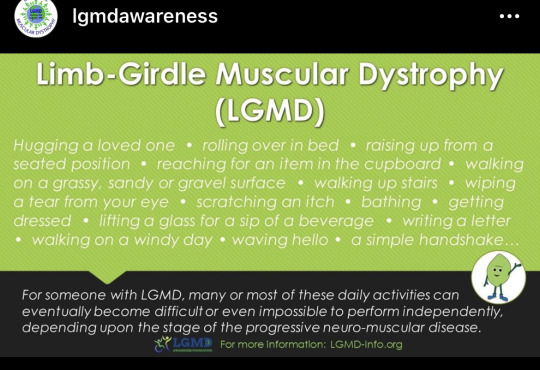
A lil education for my followers 💚
1 note
·
View note
Link
New blog w adidas read plz
0 notes